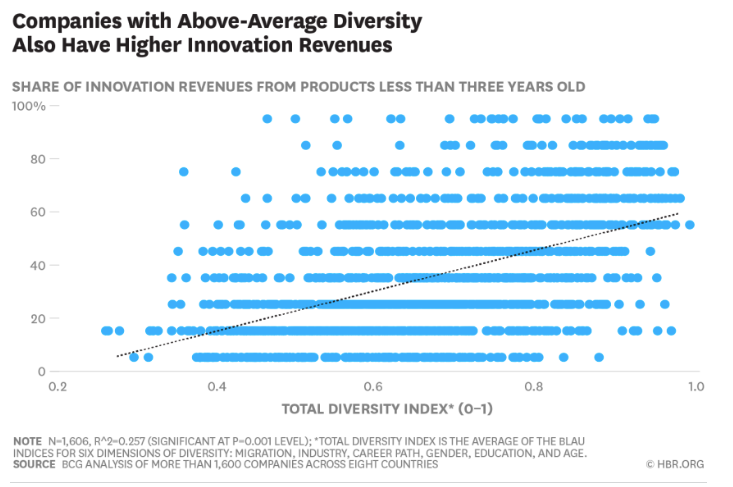Why companies with diverse leadership are more innovative
Why is it that South African companies tend to struggle so much with innovation? One very plausible reason is a real lack of diversity. Here's the evidence to prove it.
Why is it that South African companies tend to struggle so much with innovation?
One of the key reasons could be that when you look at the top leadership of just about every single JSE-listed company, you will find something truly startling.
The boards and executive committees of almost all South Africa companies are made up of white, middle-aged men.
There are very few woman who are allowed to enter the upper echelons of corporate leadership in South Africa - there is almost zero racial diversity, young people are absent; and good luck finding anyone who doesn't prescribe to a standard, traditional heteronormative lifestyle in any kind of top business position at a blue-chip corporate.
So - zero diversity in leadership = zero innovation. But why is that?
Why is it that diversity spurs on innovation in a company? What evidence is there to support this statement and is the lack of diversity at these companies then bad for the long-term financial sustainability of these companies. Should shareholders be demanding diversity?
In a study done by Rocio Lorenzo and Martin Reeves which was written about a few years ago in the Harvard Business Review - the two showed the correlation between company leadership that was diverse and higher levels of innovation and better profitability:
'We surveyed more than 1,700 companies across eight countries (the U.S., France, Germany, China, Brazil, India, Switzerland, and Austria) and a variety of industries and company sizes, examining diversity in management positions, measured with respect to gender, age, national origin, career path, industry background, and education. We partnered with the Technical University of Munich for the statistical analysis of the results. We examined the correlation of these variables both individually and collectively, with the percentage of revenues coming from products introduced in the last three years as a proxy for innovation impact. Innovative companies are taken to be those with fresher product portfolios, and unsurprisingly they turned out to be more profitable, too.
We found that indeed there was a statistically significant relationship between diversity and innovation outcomes in all countries examined. Furthermore, the more dimensions of diversity were represented, the stronger the relationship was, although the precise patterns of diversity and performance were different across cultures. We also found that diversity had gained momentum as a topic in more than 70% of the enterprises surveyed, especially in developing economies.
Most important, we found that the most-diverse enterprises were also the most innovative, as measured by the freshness of their revenue mix. In fact, companies with above-average total diversity, measured as the average of six dimensions of diversity (migration, industry, career path, gender, education, age), had both 19% points higher innovation revenues and 9% points higher EBIT margins, on average. All six dimensions of diversity had statistically significant correlations with innovation, both individually and collectively, although industry, nation of origin, and gender had slightly larger effects. And the effects of different dimensions of diversity were mostly additive, with the exception of educational background/age and career path/industry, which were somewhat correlated. Based on these findings, a broad-based approach to diversity that values multiple aspects of diversity is therefore most beneficial in terms of innovation outcomes.' - via

The question remains - WHY is this the case?
WHY does diversity create more innovation in organisations?
Here are some reasons to consider:
- Leadership which is made up of individuals from diverse backgrounds naturally creates an environment in which new, alternative, creative and fresh ideas are taken seriously. Research shows that in companies without diverse leadership, women are 20% less likely than straight white men to win endorsement for their ideas; people of colour are 24% less likely; and LGBTs are 21% less likely. That means that ideas that could result in innovations that address the needs of a vast new market are literally shutdown before they see the light of day, because the person offering the idea is from a different background to the person in power.
- Evidence also suggests that educated and competent people from backgrounds other than being white and male - are better skilled, tenacious and resilient to change precisely because they had to work so much harder to get where they are. They weren't hired on the back of having the 'right school tie' - so they tend to be more streetwise and capable of guiding a organisation through uncertain times - because their lives have always been uncertain.
- Woman are better leaders of innovation because their leadership style is more inclusive, more trusting, and women are generally better skilled at sharing knowledge freely - other research suggests. These attribute are once again crucial for creating the conditions under which innovation can flourish freely within an organisation.
Diversity then isn't just a nice PR story or something that looks good on the annual report. Innovation is vital for the future prosperity of organisations in the Fourth Industrial Revolution and the evidence in mounting that these companies cannot be led by the same kind of dated, old boys club thinking and leadership that was valued in the Third Industrial Revolution. A fresh injection of diversity is then vital if organisations are to grow effectively.
For many governments around the world the focus is on innovative growth - which then also means that quotas should then also be stepped up like they have done in Norway and other countries in Europe. But why wait for quotas, diversity is good for business, the evidence proves it.

